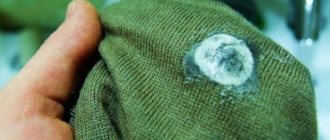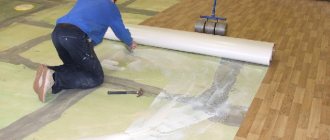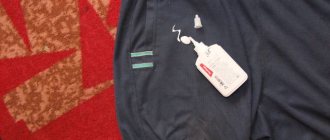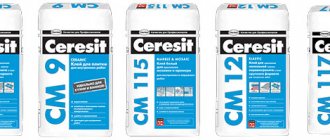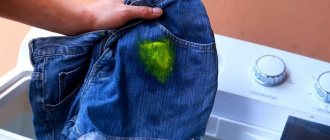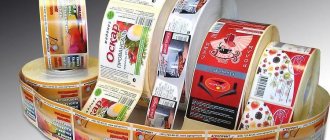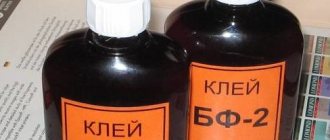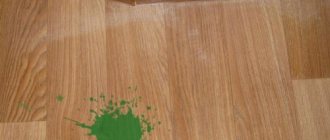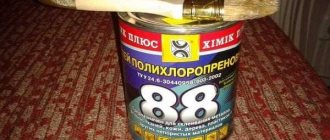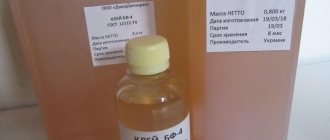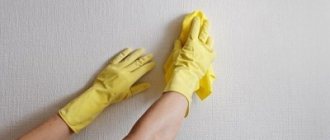General recommendations
The most important rule: try to clean clothes from glue immediately. Old traces are much more difficult to remove.
- Any glue that gets on clothing should be blotted immediately with a napkin, paper towel or soft cloth. Remove any residue with a toothpick, knife or nail file. You need to work with them carefully to avoid cutting the fabric or tightening it.
- Check the effect of the selected substances on an inconspicuous area of the product (collar on the reverse side, seams). Fabric fibers can be damaged by chemicals.
- If it is not possible to remove glue from clothing immediately, it is better to moisten the stained part with water, this will prevent it from drying out.
- You should resort to mechanical removal of glue (with the exception of Titanium) only after its pre-treatment (freezing, heating, applying alcohol, acetone, etc.)
- Before using one or another method of removing adhesive stains, you need to familiarize yourself with the recommendations for caring for the material.
The constituent components of the glue determine its properties: drying time, water and moisture resistance, viscosity and others. These qualities help determine how quickly and without much effort it will be possible to clean things from it.
Remedies for Old Glue Stains
The longer glue remains on clothing, the more difficult it is to remove. There are several methods that can help with severely dried stains.
- Blade of knife. The knife can only be used on thick fabrics, otherwise there is a risk of damaging the product. Use a blade to scrape off the top layer of glue, and wipe off any remaining residue embedded in the fabric.
- Pieces of gauze are pinned to the stain on the clothing on both sides, and the item is ironed at the highest temperature. The glue should remain on the gauze.
- Clothes stained with “super glue” or silicate glue are kept in the freezer for an hour, then the problem area is tapped with a hammer. The stain just crumbles.
- Hardware stores sell special products for removing glue from clothes; there is a chance that they will help remove old, dried drops.
These were the best ways to remove glue from clothes. But any problem is better to prevent than to solve. When working with such substances, wear old clothes or use protection (apron, robe, any cape). Glue can ruin not only clothes, but also skin. Some types of adhesives can cause burns, allergic reactions, and irritation.
Getting rid of superglue stains
It is characterized by rapid drying and reliable bonding of almost all surfaces. Stains or excess stains can be removed using anti-glue, strong solvents, vinegar, citric acid, nail polish remover, freezing and heating.
Anti-glue, refined gasoline, paint thinners
Anti-glue can be purchased at building materials stores. Apply 1-2 drops to glue marks and after 5-10 minutes wipe with a paper napkin.
White spirit, acetone, and kerosene are used on non-colored cotton and linen fabrics. Their use on wool, velvet, silk and synthetic fabrics is prohibited. Thin synthetics can dissolve under their influence.
- Soak a soft cloth with one of the selected substances.
- Wipe off dirt with it.
- Wait 20-30 minutes.
- Wash the item as usual.
It is allowed to repeat the procedure no more than 2-3 times for an old stain. If most of the dirt has been removed, it is better to try to wash off the glue by hand. This will prevent tissue damage.
Note: Acetone is effective, but can sometimes leave yellow stains.
Vinegar
Suitable for removing glue stains even from delicate fabrics, but is contraindicated for denim.
- Dilute one tablespoon of vinegar in warm water (one glass).
- Moisten a soft cloth in the resulting solution and place it on the adhesive trace.
- After 20-30 minutes, remove the dissolved glue with a napkin. You can soak the product in this solution for half an hour.
- Then wash as usual.
Nail polish remover/acrylic nail softener
- Soak a soft cloth with one of the selected products.
- Treat the part of the item stained with superglue.
- After 20-30 minutes, clean the dirt with the hard side of a dishwashing sponge.
- Wash the item as usual.
When working with delicate fabrics, it is better to use an acetone-free liquid.
Dishwashing liquid will help get rid of greasy stains that may remain after removing the adhesive residue.
Exposure to high or low temperatures
There are two effective ways:
- From the wrong side of the product, through gauze or soft fabric, apply a hot iron to the superglue mark for a split second. After half a minute, apply the iron again. Repeat two to three times. Remove remaining adhesive mechanically - rub with your hands, a toothbrush or the hard side of a sponge.
- Keep the soiled clothes in the freezer for 1-1.5 hours. Pull out and rub the glue stain with your hands or a toothbrush with medium-hard bristles. When frozen, the glue crumbles and easily comes off the fabric. Wash clothes. It will take several washes to completely remove the stain. The freezing method is also applicable for delicate fabrics (organza, silk, viscose).
Citric acid, dimexide, white, powder
Here are a few more ways to remove superglue stains from clothes:
- Dissolve citric acid (20 g) in warm water (half a glass). Apply the resulting solution to the adhesive marks with a soft cloth. After 5-10 minutes, rub the stained area with a hard sponge and wash the item.
- The nail file is suitable for removing glue from suede or leather products. It is enough to move it with light circular movements over the contaminated surface.
- Dimexide (a medicine for the treatment of bruises and purulent wounds sold in pharmacies) allows you to get rid of glue stains from any type of fabric. Use a soft cloth soaked in a solution of dimexide (2 tablespoons) and room temperature water (half a glass) to wipe the contaminated areas. After 10-15 minutes, wash the item.
- Whiteness applies to white things. Apply the product to the adhesive stain and rub it with a cotton cloth. The sponge will not work; its small fibers will cling to the glue.
How can you remove glue stains at home?
Universal solvents are compounds that help get rid of all types of glue, regardless of their origin. They must be used carefully, since they are based on caustic substances.
An effective, inexpensive and effective product is “Super Moment Anti-Glue”, which costs about 100 rubles per package. It copes not only with removing adhesive stains from Superglue, but also with other adhesives: PVA, contact adhesives, etc.
The product has a gel consistency, thanks to which it does not spread over the surface of the fabric and does not stain clothes.
Mode of application:
- Place a paper napkin under the back of the soiled item.
- Apply the composition to the stain.
- Cover it on top with another napkin and leave overnight.
- Put away napkins, wash things.
Other universal compositions include:
- Acetone. The substance has a pungent odor, so it should only be used in areas with good ventilation. To avoid damaging the fabric, first test the product on an inconspicuous area. Moisten a cotton pad with acetone and use it to treat the stain. You cannot leave it on the fabric for a long time.
- Nail polish remover . It contains acetone, but in a lower concentration, so when removing traces of persistent glue, it can be left on the item for 10-15 minutes. Remove dirt using a stiff brush, for example, the back of a sponge.
- Petrol. It has a fatty base and a pungent odor. Therefore, it is recommended to use it outdoors. The composition is applied to gauze folded in several layers, which is used to systematically treat stains on clothing.
- Dimexide. This is a pharmaceutical solution that is used for medicinal purposes. To remove sticky traces you will need a 99% concentrate. To remove fresh stains, simply apply Dimexide to a napkin. It wipes away the dirt until it disappears completely. If the glue has dried, make a lotion, keeping the solution on the fabric for no longer than 5-15 minutes.
All universal compositions are capable of dissolving not only glue molecules, but also paint. Therefore, when processing colored fabrics, you need to test the selected product on an inconspicuous area.
Removing traces of silicate or wallpaper glue
Silicate or wallpaper glue can be removed from clothing using detergents such as:
Soda and laundry soap
- Add two tablespoons of baking soda to one liter of warm water.
- Wash the glue stain well with regular laundry soap.
- Dip the soaped part of the clothing into the soda solution and leave for 40-50 minutes.
- Wash by hand or machine.
For suede items you need to use a special shampoo or soap.
Washing powder
- Dissolve 200 g of powder in 4 liters of warm water.
- Leave the soiled item in this solution for 3 hours.
- Afterwards, squeeze it well and try to remove the dirt with the hard side of a sponge or a medium-hard toothbrush.
Or rub the stained area with laundry soap and soak for 4-6 hours in warm water. After washing.
What to do with other species
- Wallpaper and wood glue can be easily removed with laundry soap. The product is thoroughly soaped, rubbed and soaked in water for 5 hours. Finally, wash as usual with detergent.
- Stains from epoxy glue are washed off with a mixture of equal parts alcohol and turpentine. In this case, both acetone and solvent 646 will also be effective.
- Summer residents use traps for insects and rodents with a sticky base, traces of which end up on clothes. This is where purified gasoline or vegetable oil will come to the rescue. The stain is wiped with gasoline, and the oil is poured directly onto the fabric. All you need to do is leave it on for 5-100 minutes and wash it with dishwashing detergent.
- For fresh and small stains of casein glue, use gasoline or kerosene. Ammonia is universal for all types of fabrics. Blot the stain with any of the products and leave for 30 minutes to act. Finally, wash with powder.
- Silicone sealant can be removed from clothing using table vinegar. It is applied so much that the fabric gets wet. The duration of exposure is 30 minutes. Then wash with laundry soap. Sometimes it is possible to remove the dry film with a sharp knife. On natural and light-colored fabrics, silicone can be washed off with a swab and acetone.
What to do with a PVA glue stain
It is easy to remove fresh traces of PVA glue from clothes by washing with laundry soap. Or place the soiled part of clothing that is not afraid of high temperatures, with the wrong side under running hot water. After 20-30 minutes the glue will come off the fabric.
An old stain on cotton, linen or denim fabrics will go away if you wipe it with a cotton cloth soaked in alcohol.
A stain from PVA glue on a suede product must first be held over steam for 5-7 minutes, and then carefully remove the dirt with a paper towel or napkin soaked in ammonia.
The freezing method is also suitable for delicate fabrics. Place the clothes in the bag in the freezer for 1-1.5 hours. Then carefully remove the glue from the material with your hands, which has become brittle from the cold.
Other methods for removing contaminants
In the question of how to remove glue from clothes, you can resort to more radical methods of influencing the damaged item. Among them are:
- use of acetone;
- exposure to extreme temperatures;
- ironing;
- use of gasoline;
- cleaning with vinegar.
Removing traces of glue using acetone cannot be used on colored and thin fabrics, since the risk of damage to the item is too high. This technology is not suitable for processing products made of synthetic materials. In other cases, housewives often resort to the technology of treating products damaged by glue using acetone. An ordinary cotton swab is dipped into the product, and when it is saturated with acetone, the area of material damaged by the glue is treated. The stain must be thoroughly soaked in acetone, after which you can begin washing and rinsing the product.
If you decide to remove glue from clothes using cold, then keep in mind one feature of the technique. It has the right to life only if the adhesive mass is slightly spread over the surface. At the same time, the composition must be applied in a sufficiently thick layer or take the form of a thick drop. The processing technology will be similar to the method of cleaning material from dried chewing gum. Housewives pack the item in a plastic bag and put it in the freezer for a while. In the cold season, a balcony is quite suitable for these purposes. You can proceed to active actions as soon as the damaged item freezes well and hardens. Try to carefully remove dried glue using a needle or knife with a narrow blade.
You can also get rid of glue on fabric by exposing the material to high temperatures. First, you will have to give the soiled item an intensive wash and ensure it dries completely. Next, you need to turn on the iron and set it to the highest possible temperature. At this stage, do not forget to take into account the material of the product so as not to deform the item irrevocably. When the tool is prepared, the area with traces of glue is ironed on both sides.
What will help dissolve epoxy glue?
Alcohol
- Carefully remove large traces of glue with a knife, spoon or nail file.
- Wipe the dried stain with a rag or cotton-gauze swab soaked in alcohol.
Pharmacy turpentine
- Apply to stains and leave for 7-10 minutes.
- Then use a soft bristle brush to scrub the glue stain.
- Wash the item with powder and add fabric softener, which will help get rid of the characteristic pungent odor of turpentine.
- An old stain can be removed with a mixture of alcohol (a teaspoon) + pharmaceutical turpentine (a teaspoon). Also, first apply the solution to the stain, wait 5-8 minutes, and gently rub with a brush.
Ironing
Place a plain cloth or paper towel under the stain on the wrong side of the product. Iron the stained area from the wrong side. The glue will melt and be absorbed into the substrate. Remove any remaining faint stains by wiping with a sponge soaked in alcohol. Next wash on standard cycle.
Super glue
It is not always possible to remove superglue. This is a very powerful composition that quickly sets and holds together a variety of surfaces. The product can be removed without consequences only from dense and mechanically resistant fabrics. You can remove the stain using anti-glue. You can also clean the material from super adhesive using gasoline and white spirit. These substances are aggressive and discolor the fabric, and therefore they are used exclusively on natural materials without a pattern.
The following recipe will help you get rid of superglue:
- moisten a cotton wool with gasoline and walk over the stain;
- leave clothes for half an hour;
- repeat the procedure, and then send it to the wash.
Dried glue is extremely difficult to soak. When cleaning clothes, do not forget to wear hand gloves so as not to injure your skin. You can remove superglue from jeans using an iron. It is enough to iron the stain from the wrong side several times. Once the glue becomes brittle, it will fall off the fabric.
Another way to wash off superglue is vinegar (but this method is not suitable for denim items), 1 tbsp. l. The products are diluted in a glass of warm water. Soak the entire item or a separate area for an hour. Then wash it in the usual way.
Ekaterina Frolova
Founder of the Atelier of Knitted Ideas, fashion columnist, author with 7 years of experience.
Ask a Question
It is more difficult to answer the question of how to remove superglue from delicate clothes, because it is almost impossible to remove the glue mechanically - the fabric will suffer. In this case, the proposed procedures are repeated several times, but when the glue has dried, it is not possible to remove it from clothes at home.
Hot melt adhesive
Isopropyl alcohol (isopropanol) is applied to the stain with a cotton swab. The glue softens, allowing it to be separated from the fabric. Also suitable methods:
- freezing in the freezer. At low temperatures, hot-melt glue becomes brittle and can be scraped off with a spoon or sandwich knife.
- heating with an iron. Place a cotton cloth on the stained area and iron it without steam for 7-15 seconds. Lifting the piece, you can see that the glue has begun to transfer to it. Repeat ironing until it is completely transferred to the substrate.
Initial steps for removing super glue
If the adhesive does get on the dress, then immediately begin removing it. So, after drying, it will take a lot of effort to remove the mark. To determine how to remove Moment glue from clothing, study the symbols on the label from the clothing factory. It is important that these signs guarantee proper care of the product.
Before starting work, be sure to spread the item on the table. This is the only way to stop the spread of the stain. Next steps should be as follows:
- place a coin under the stain, preventing the adhesive from getting into the fibers;
- use a paper towel to soak up the glue;
- scrape off its remains very carefully with a kitchen knife;
- wash the item properly.
However, Moment is rubbed off in this way only if very little time has passed from the glue hitting the fabric to the start of its removal.
Cold cleaning
It is optimal to remove Moment adhesive using the cold cleaning method. To do this, roll the item so that the stain remains on top, put it in plastic and put it in the freezer for a couple of hours. Low temperatures will harden the fabric fibers, and superglue layers can be easily removed with tweezers or a knife.
When the dirt has filled a large area of the fabric and lies in a thick layer, it can simply be broken. To do this, take a kitchen hammer, wrap it in a plastic bag and gently tap the hardened glue. After such actions, the item of clothing is dipped in soapy water and washed. Before washing super glue, be sure to check the manufacturer's label to determine whether it is hand or machine washable.
Hot cleaning
In addition, it is possible to remove super glue by exposing it to high temperatures. Already at 80 degrees the composition begins to melt and can be easily removed from any type of fabric.
- For these purposes, you will need to take two pieces of cotton fabric. Place one of them under the stain and cover with the other.
- Heat the iron and iron the stain with force. It is important not to miss the moment when the composition softens, otherwise you will have to reheat the area of contamination.
- If the layer is too thick, use a sharp object to remove the glue. Clean carefully to avoid damaging your clothing. Then go over the stained area with the iron again.
- When the process is finished, wash the item.
It is important to note that this method is suitable for products made from synthetic and artificial materials. For delicate, expensive items made from natural fibers, gentle methods and products are used to remove Moment glue from the fabric.
Fat
Natural fat is a unique oily substance of plant and animal origin. It is able to soften and remove even old adhesive residues from the material. So, use butter, margarine or spread. Use one of these products to rub the adhesive mark just until it softens.
To remove residual marks, fill a bowl with warm water and add liquid soap. Rinse the item thoroughly by hand. If necessary, machine wash the item with added stain remover to remove greasy stains. If the material is expensive, then you can remove superglue from clothes using the same method using Vaseline or glycerin.
Soap solution
So, to remove super glue from clothes, just use soap dissolved in water. To obtain a concentrated solution, grate laundry soap and dilute it in hot water. Soak the stain with this mixture and leave for a couple of minutes. After softening the contaminated area with a knife, remove the glue, then wash.
It is not recommended to use this method to remove super glue from clothes that cannot be washed in hot water. So, be sure to study the product label, which indicates the optimal temperature for washing.
Titanium
This glue can be removed from the fabric by mechanical action.
- Place the stained area on a hard surface.
- Place gauze or paper towel over the glue stain.
- Tap the cured glue with the handle of a knife or a hammer.
- Remove the remains with a nail file.
Getting rid of glue from fabric at home is quite easy and safe. But when choosing a method, it is necessary to take into account the type of material and brand of glue. If the methods turned out to be ineffective or there is no confidence in the safety of the chosen method, then you should contact a dry cleaner.
Special means
Sometimes it happens that none of the above methods helps. Don’t rush to panic if you’ve tried everything and still don’t know how to remove glue from clothes.
Today, the market for goods and services offers an exhaustive range of special compounds. Manufacturers have worked hard and developed effective substances that can remove any kind of stains, including those from glue.
Anticlean
Anti-glue is the most effective composition for removing stains from any type of glue. A wide range of products from different manufacturers allows you to purchase the most optimal asset for removing stains in a particular case.
So, anti-glue is freely sold in construction stores. This development is designed to remove old adhesive residues from any coatings and materials. Before purchasing, carefully study the method of use. The composition has a delicate effect on any type of material, due to which it preserves the structure of the fabric unchanged.
To remove the adhesive from clothing, you need to treat the stain and wait about 10 minutes. After the procedure, the product is rinsed in warm soapy liquid, while changing the water to clean water several times.
Conclusion
The article discusses various methods for removing glue stains that effectively remove both new and old stains. It is true that it is better to prevent glue from getting on your favorite thing than to later look for the answer to the question of how to remove super glue from clothes.
Therefore, when working with adhesive compositions, we recommend wearing gloves and worn-out clothing that you won’t mind getting dirty. If contamination cannot be avoided, the surfaces of the fabric should be treated carefully and in an exclusively suitable way. When none of the presented methods work, you will have to spend money and take the product to the dry cleaner.
Before starting work, we recommend watching a video review to help combat glue stains:
